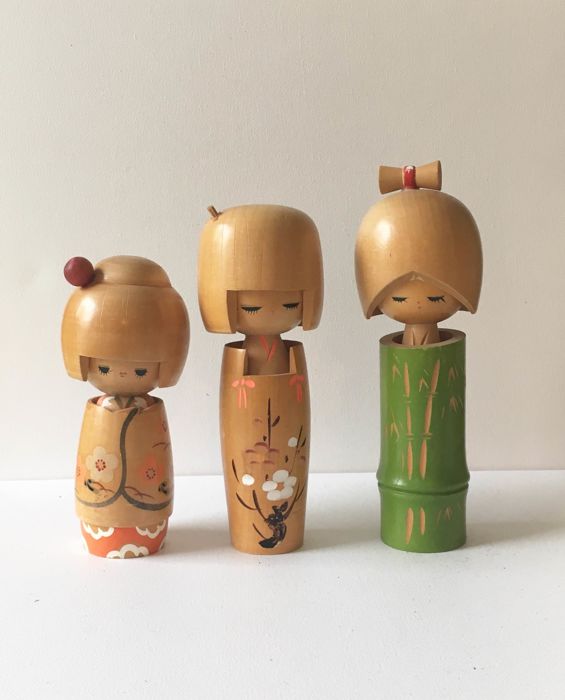Vintage Kokeshi
Kokeshi are Japanese wooden dolls, originally from northern Japan. They are handmade from wood, have a simple trunk and an enlarged head with a few thin, painted lines to define the face. The pattern of the trunk of the doll usually has a floral print although sometime there are variations. The bottom of the doll usually has the signature of the artist.
Kokeshi were first produced by kijishi artisans proficient with a potter's wheel near the Tōgatta Hotsprings where kokeshi-making techniques spread to other spa areas in the Tōhoku region. It is said that these dolls were originally made during the middle of the Edo period (early 1800’s) They might have been originally made by farmers who started carving these dolls during the long winters and sold as good luck dolls designed for fertility or a good harvest. These dolls were also for children. Eventually they were sold at hot springs for the many travelers who were visiting the hot springs in the north-east of the country. In the 1920’s these dolls started becoming collectors items. From then kokeshi artists started experimenting, making very large kokeshi, very small kokeshi, different shapes, styles, etc.
It wasn’t until after WW2 when Japan was occupied by US military forces, that these dolls became a curiosity overseas. Servicemen would bring back the dolls for their wives or family in America because they were particularly cute. Since then, there have been new types of Kokeshi with many artists experimenting with new styles that we follow, as well as some of the more traditional styles.
The woods used for kokeshi vary, with cherry used for its darkness and dogwood for its softer qualities. Itaya-kaede, a Japanese maple, is also used in the creation of both traditional and creative dolls. The wood is left outdoors to season for one to five years before it can be used.
"Traditional" kokeshi dolls' shapes and patterns are particular to a certain area and are classified under 11 different types named for the hot spring area that they originate from: Yajiro, Togatta, Narukyo, Sakunami, Tsuchiyu, Yamagata, Zao, Nanbu, Hijiori, Kijiyama, Tsugaru.
"Creative" kokeshi (新型こけし shingata-kokeshi) are the new style of kokeshi developed after WW2 that allow the artist complete freedom in terms of shape, design and. They are not particular to a specific region of Japan and generally creative kokeshi artists are found in cities.
When looking for a vintage kokeshi there are 2 ways to choose. Some collectors look for a particular style to add to a collection, and some just look at a face and fall in love with it or the cut or style. This is part of the joy of being a kokeshi collector.




